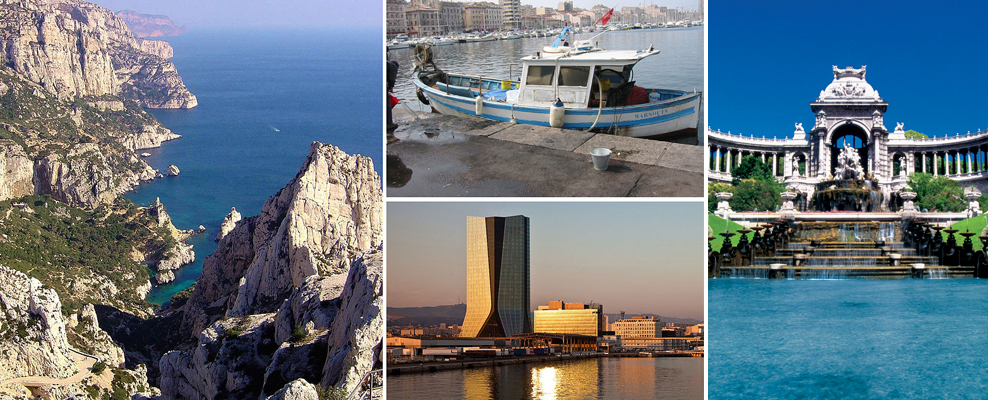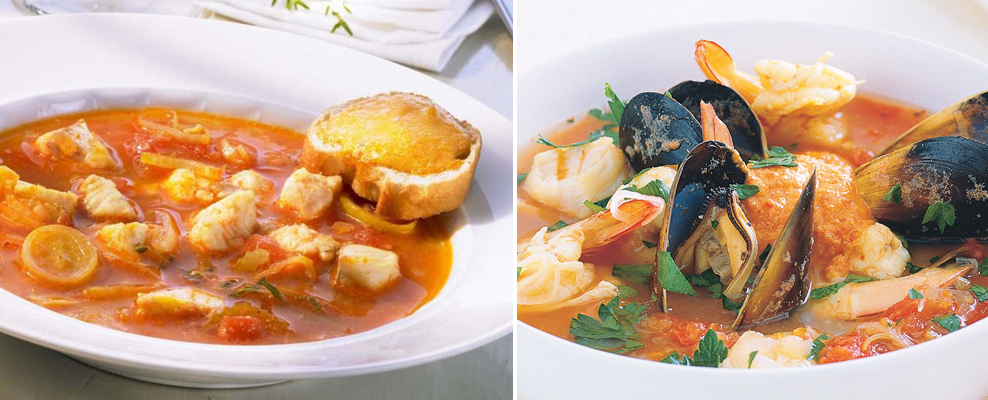Is it a simple fish – a broth with a bunch of fish other and seafood thrown in? It may or may not have been such a simple affair at one time, but Bouillabaisse – the iconic culinary symbol of the French port city of Marseille – is today more like an elaborate Gastronomic Theater.
As is the case with many famous foods, there are many versions of the origins of the Bouillabaisse. The most romantic version claims that the Roman Goddess of Love and Beauty, Venus, served it to her husband Vulcan in order to lull him to sleep while she consorted with Mars.
There is also the legend which says that Bouillabaisse was first brought by the angels to The Three Marys of the Gospel when they were shipwrecked in the marshes between the two branches of the Rhone River near Arles. Another version says that the Bouillabaisse was brought by the Greek Phocaeans from Asia Minor when they founded Marseilles in about 600 B.C.
They brought with them a fish soup called ‘kakavia’ that was the basis for the future Bouillabaisse. Whether the above is true or false, in the culinary writings of the Ancient Greeks of the period AD 170 – 230, there are mentions of boiled fish, cooked in many unspecified ways, as well as one fish stew made with grayfish, oils, herbs, salt and caraway seeds.
Leaving the ancient myths and legends aside, the contemporary belief is that Bouillabaisse started in Marseilles as a simple, wholesome, filling, family fish soup, using those fish like rockfish and shellfish, which were too bony to sell to customers. The dish was made by boiling the fish in a cauldron of sea water, over a wooden fire and seasoning the soup with fennel and garlic. Tomatoes started being added to this soup in the 17th century, after they were brought from America and introduced in France.
It is from such humble beginnings that the Bouillabaisse kept on gaining in popularity – and, complexity – to become today’s expensive, iconic culinary symbol of Marseille.

‘Bouillabaisse’ comes from the Provencal Occitan word ‘Bolhabaissa’, a compound that consists of two verbs ‘bohlir’ (to boil) and ‘abaisser’ (to reduce heat, simmer). Thus the name ‘Bouillabaisse; comes from the method of preparation. The broth is first boiled and then the different kinds of fish are added one by one, and each time the broth comes to a boil. The heat is lowered.
What makes the Bouillabaisse different from other fish soups is the use of the local bony Mediterranean fish and the selected Provencal herbs and spices put in the broth.
Traditionally, there should be at least three kinds in a ‘real and authentic’ Bouillabaisse. Typically these are scorpion fish, sea robin and European conger. Also included can be turbot, monkfish, mullet, silver hake and gilt-headed bream. The dish includes seafood like mussels, sea urchins, velvet crabs, spider crabs or octopus and langoustine. Vegetables like onions, leeks, celery, tomatoes and potatoes are simmered together with the broth and are served with the fish.

Bouillabaisse of Marseille kept on gaining in popularity but there was also a downside. It became so popular that unscrupulous elements could serve inferior versions of it to the avid tourists at high prices, and get away with it. Perturbed by the debasement of their iconic dish in mushrooming tourist traps, about a dozen or so worried restaurateurs of Marseille came together to draw a ‘Bouillabaisse Charter’ in 1980. The original signatories included famous restaurants like Le Miramar, Chez Fonfon, Le Caribou, Chez Cruso, Le Rhul, L’Epuisette and Peron. Now there are many more who subscribe to the Bouiilabaisse Charter.
The charter begins with “It is not possible to normalize cooking,” but goes on to state that the recipe for Bouillabaisse should include at least four of the following types of fish: rascasse (scorpion fish or rockfish), araignee (spider crab), galinette/rouget grondin (red mullet), fielas/congere (conger eel) and chapon/scorpene (red scorpion fish). Optional extras could be: Saint Pierre (John Dory), langouste (crayfish), bauroie/lotte (monkfish) and cigale de mer (a lobster-like creature). Among the other ingredients should be tomatoes, potatoes, onions, parsley, bouquet garni, fennel, garlic, olive oil and saffron. Some places make it more-Marseille by adding healthy doses of pastis, just before serving.
I had my first Bouillabaisse at the Chez Fonfon, the restaurant started in 1952 by Alphonse Mounier. I also had Bouillabaisse at the famous Miramar. The service of the dish is nothing short of high drama of restaurant theater. It is usually served in two stages. First comes the broth, accompanied by croutons, which you rub with a clove of whole garlic and spread with the provided ‘rouille’, a bright orange mayonnaise flavoured with saffron, cayenne and more garlic. Literally ‘rouille; means ‘rust’!
The second course is the platterful of freshly cooked whole fish. The essential rule is to cut the fish at the table, in front of the guests.
So, I first enjoyed the soup and then the assortment of fish/seafood. I ate my fill accompanied by healthy sips from the recommended wine – a Sauvignon Blanc. I was soul-satisfied. I paid the bill, adding a tip large enough for the waiter to give me a huge smile. The ‘dessert’ was a leisurely stroll down the front. The Bouillabaisse-happiness was enough to ensure a good night’s sleep!
P.S.: Do please remember that 14 December is National Bouillabaisse Day.
